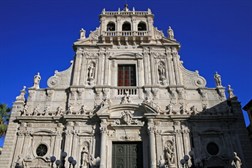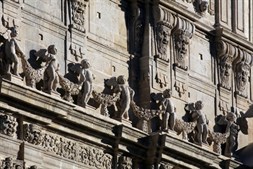Acireale
 Located in the historical centre of AcirealeAcireale is a city in the province of Catania. Like other Sicilian towns that have the prefix Aci (such as Aci Catena, Aci Castello), Acireale also derives from the legendary Xiphonia, the foundation of which is intertwined with the myth of the love affair between the nymph Galatea and the shepherd Acis. The reconstruction after the earthquake of 1693 has made it one of the jewels of Italian Baroque., a few steps from the Cathedral, the Basilica of San Sebastiano (Saint Sebastian) is the most famous monument of the Sicilian city. It was built starting in 1609, when the confraternities of the church bought the area where there was a chapel dedicated to the saint, which was too small for the needs of the community of the faithful. The work was completed only in 1652, but the extensive damage caused in the entire east of Sicily from the disastrous earthquake of 11 January 1693 also struck Acireale, and the Basilica of San Sebastiano, provoking the collapse of the choir through which some frescoes were lost that adorned the inside. Its present appearance dates from the reconstruction work in the early years of the eighteenth century, financed in large part by the bequethals of wealthy citizens.
Located in the historical centre of AcirealeAcireale is a city in the province of Catania. Like other Sicilian towns that have the prefix Aci (such as Aci Catena, Aci Castello), Acireale also derives from the legendary Xiphonia, the foundation of which is intertwined with the myth of the love affair between the nymph Galatea and the shepherd Acis. The reconstruction after the earthquake of 1693 has made it one of the jewels of Italian Baroque., a few steps from the Cathedral, the Basilica of San Sebastiano (Saint Sebastian) is the most famous monument of the Sicilian city. It was built starting in 1609, when the confraternities of the church bought the area where there was a chapel dedicated to the saint, which was too small for the needs of the community of the faithful. The work was completed only in 1652, but the extensive damage caused in the entire east of Sicily from the disastrous earthquake of 11 January 1693 also struck Acireale, and the Basilica of San Sebastiano, provoking the collapse of the choir through which some frescoes were lost that adorned the inside. Its present appearance dates from the reconstruction work in the early years of the eighteenth century, financed in large part by the bequethals of wealthy citizens.
 The design and construction of the magnificent façade was the work of Angelo Bellofiore. Statues of saints, angels’ heads, apotropaic masks and various other decorations, combined with floral motifs, covering the surfaces of the pilasters (18 in all) and door jambs. A choir made up of 14 putti holding garlands of fruits and flowers (photo 2) separate the first from the second order, while the three mullioned window of the bell loggia overlooks the entire structure. The churchyard is bordered by a balustrade on which are placed ten statues, sculpted in 1754 by Giovan Battista Marini, designed by Pietro Paolo VastaPietro Paolo Vasta (1697-1760) was a painter from Acireale, most famous for the frescoes in the cathedral and other churches of his native city. and representing many characters in the Old Testament: Judith, Yael, David, Joshua, Moses, Aaron, Joseph, Judas Maccabaeus, Gideon and Samson.
The design and construction of the magnificent façade was the work of Angelo Bellofiore. Statues of saints, angels’ heads, apotropaic masks and various other decorations, combined with floral motifs, covering the surfaces of the pilasters (18 in all) and door jambs. A choir made up of 14 putti holding garlands of fruits and flowers (photo 2) separate the first from the second order, while the three mullioned window of the bell loggia overlooks the entire structure. The churchyard is bordered by a balustrade on which are placed ten statues, sculpted in 1754 by Giovan Battista Marini, designed by Pietro Paolo VastaPietro Paolo Vasta (1697-1760) was a painter from Acireale, most famous for the frescoes in the cathedral and other churches of his native city. and representing many characters in the Old Testament: Judith, Yael, David, Joshua, Moses, Aaron, Joseph, Judas Maccabaeus, Gideon and Samson.
Access to the inside is through a large door from the end of the nineteenth century in iron, with Gospel scenes carved on bronze panels. It consists of a Latin cross with three naves and has a beautiful marble floor. There are numerous frescoes, especially by Pietro Paolo Vasta, dating back to the thirties of the eighteenth century: the Pietà and the Trinity with Saints Mark the Evangelist, Jerome, and Liborious Bishop. The works of Baldassarre Grasso, Vasta’s master, have in turn been lost due to the earthquake of 1693. To the right transept, behind the triple door above the altar, there is the statue of Saint Sebastian, carried in procession on a silver pageant every January 20. Worthy of note is the Museum, located near the sacristy.
